by Adi Hong-Tan
Not Vital – 10 Paintings
August 27 – October 23, 2022
Galerie Urs Meile Beijing
‘6,000 feet beyond man and time,’ extols the German philosopher Friedrich Nietzsche of the Engadine valley. I’ve come here, to the Swiss Alps, in pursuit of Swiss artist and international nomad Not Vital. On my first day, he brings me to Not dal Mot, the sculpture park of his Fundaziun Not Vital. We go down a meandering path and arrive at a meadow-like clearing. Overgrown under the summer sun, it rolls down the valley with wild grasses and snowbells. An asymmetrical steel platform juts out over the slope, suspended precariously on one end onto higher grounds. Weathered by the elements, it has the colour of reddish earth. From a distance, the flat surface of the platform twists slightly. But the optical illusion is a tease. Come closer, and the platform straightens out. Welcome to Palc (‘Stage’, 2011), one of the artist’s installations in the park.

Image courtesy the artist. Photo Eric Powell.
‘Come up’, he beckons, inviting me to join him up onstage. I eagerly climb up the steps, then realise in the briefest second of half-hesitation that the structure wobbles by design. On top, you float above wild grasses and snowbells up towards the mountains as if on a magic carpet. Like much of Vital’s canon, Palc is a theatre of oscillating meanings. Its ambiguity of form, whether stage, sculpture or shelter, hosts a central paradox. Onstage, you are on a pedestal, but you realise immediately that you are not the star of the show. The backdrop becomes centre-stage as the mountains envelope you. ‘What we see’, points out art critic Anthony Downey, ‘and what we get when we look at the work of Not Vital are often two very different things.’ We are asked to reconsider fixed categories and to take another look at familiar objects. We are asked to think concepts through on different planes at the same time. We are invited to push the boundaries of imagination. Seen through the artist’s eyes, seen anew with childlike imagination, the world opens up with endless possibilities.
Much of Vital’s oeuvre is imbued with what I shall call this invitation towards imagination. His practice ranges from drawing and sculpture, to painting and installation, and on to what he has christened ‘SCARCH’, built structures – like Palc – that straddle the boundaries between sculpture and architecture. Across these diverse works, the artist explores certain themes that preoccupy him, themes such as animals and people, nature and habitat. According to curator Alma Zevi, this diversity belies a ‘multi-lingual’ coherence. Vital ‘can move as easily from one material or subject matter to another, as he does with …[his] six languages.’
In more senses than one, the artist’s invitation towards imagination is ‘multi-lingual’, especially when understood in the context of his background. Vital was born in 1948 in the village of Sent in the Lower Engadine. From his childhood house, you can see panoramic views of the surrounding mountain ranges, indifferent to national borders, stretching out into Italy and Austria. The artist’s unusual given name, Not, is a traditional one in his Romansch mother tongue. It is spoken regularly today by some 60,000 people. As a Romansch speaker, he emphasises, ‘you need to learn other languages. If you go 20 minutes one way, the people speak German, and 25 minutes the other way they speak Italian. Depending on the context, you change the language you speak.’ Such hybridity characterises Romansch grammar itself – a love child of Vulgar Latin, yet one reared by centuries of German contact. From his earliest infancy, Vital experienced this crisscrossing of political and linguistic borders. Concepts and categories, that to many others would have appeared immutable, to him are pregnant with possibility.
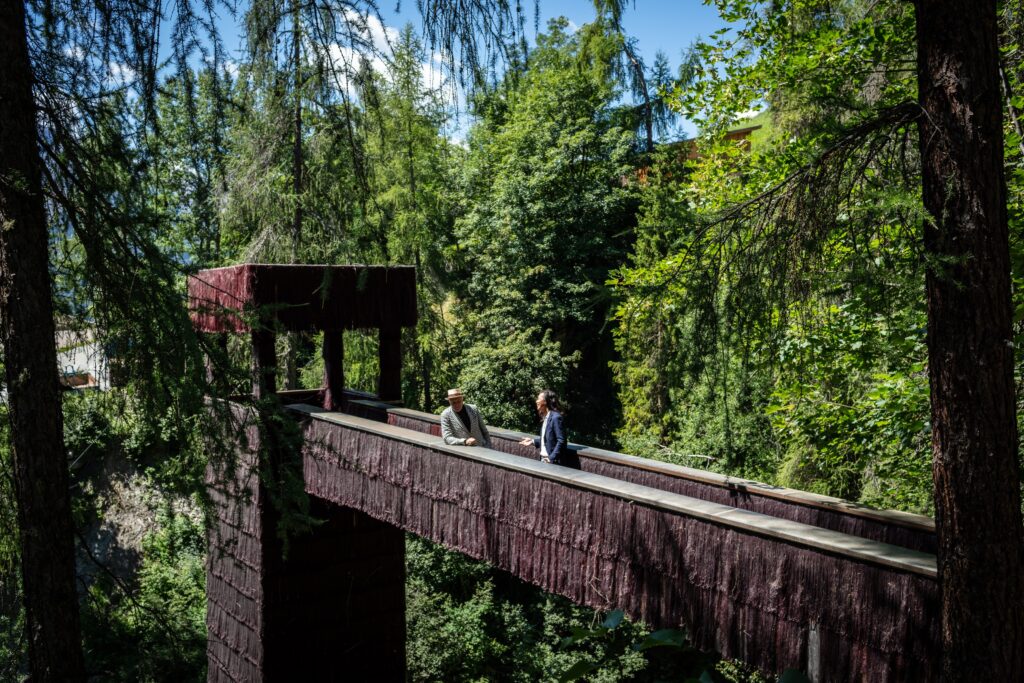
Such a viewpoint is also a natural corollary of Vital’s incessant nomadism. Notwithstanding his own undoubtable wanderlust, he shares this need to travel with many in the Romansch community. ‘There was no industry up here,’ recounts Vital. ‘Most people were farmers. You could only have – at maximum – seven cows, but then also seven children. Life was tough. At a certain age, people had to go abroad.’ Though from a family of well-to-do timber merchants, Vital also had to leave Sent to pursue educational and professional opportunities elsewhere. First, aged 14, he was sent to Chur for boarding school in German; then, from 1968 until 1969, he studied art in French at the Université Expérimentale de Vincennes in Paris. Travelling across linguistic and national borders again post-art school, he had a brief stint in Rome before settling down in New York in 1974. Today, he divides his time between Sent, Beijing and Rio de Janeiro. Even amidst the affluence of present-day Switzerland, traveling and working outside his native language remains an experience the artist shares with many Romansch speakers, 40% of whom live outside their home cantons for education or work. Not for him, then, is a navel-gazing critique of the neuroses of his own society. His background compels him to travel across cultural boundaries, to express his thoughts multilingually, and to see the world through different lenses.

Seeing the world afresh, moreover, comes to Vital with a deep sense of respect for history and continuity. Part of the explanation for this lies, likewise, in his roots in a minute, historic community. ‘Everyone is aware’, insists the artist, ‘that you’d have to do something with our language. When I was at high school, I translated Antoine de Saint Exupéry’s ‘The Little Prince’ from French into Romansch.’ His sense of custodianship for heritage finds expression in the incorporation of different traditions of art and craftsmanship into his practice. We see this clearly in his emphasis on fine workmanship, such as while working with glass blowers in Murano, Italy, or with silver smiths in Agadez, Niger. Similarly, we see this in his dialogue with older artistic traditions, whether European or Chinese; or in his foundation’s acquisition in 2016 of an Engadine landmark, Schloss Tarasp. Vital’s invitation towards imagination does not presuppose a clean slate. On the contrary, he shows that new ideas can stand creatively on the foundations of things past.
In his practice, a theme that the artist has continued to revisit since the 1980s are animals. His fascination with the topic, certainly, goes back to his childhood in a largely farming community. Yet, as explained by Zevi, Vital often sees the artistic potential in overlooked things and chance encounters. Pertinent examples include his iconisation of the cow tongue and dung as biomorphic abstraction. We are invited to see these objects anew: in their own right, and as conduits for novel ideas and sensations.


The earliest of Vital’s iterations of Tongue dates back to 1985, when he chanced upon some severed cow tongues at a butcher’s shop in Lucca, Italy. He bought some, then had one cast in bronze. It is displayed, not horizontally as is customary on a kitchen table, but vertically, standing 39 centimetres tall. An ordinary animal body part has thus become an obelisk-like sculpture, erect with minimalist monumentality. As art historian Georgia von Albertini observes: ‘He has a penchant for liberating objects or organs…from their conventional, mundane use and transforming them sculpturally into surreal, minimal objects.’
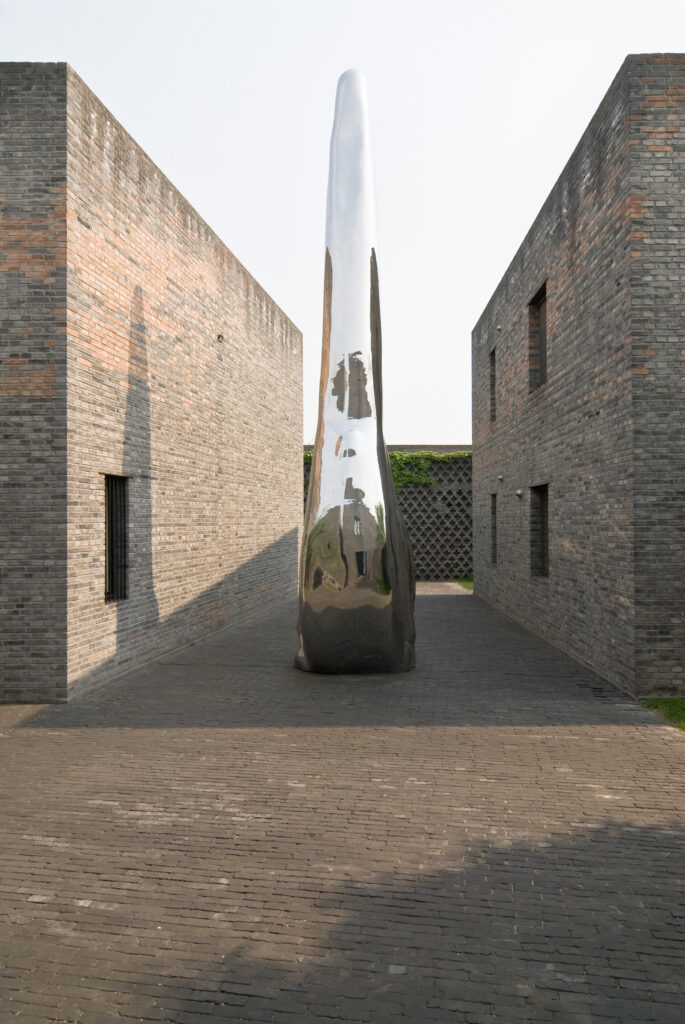
Vital’s Tongue evokes slaughter and sensuality. This organ, observes art curator Thomas Kellein, ‘uniquely links our cognitive capacities…our sex drive and our consumption of food and drink.’ The artist has since resized Tongue in ever larger dimensions and in different materials. In so doing, highlights Zevi, he is exploring ‘how…different materials and sizes impact the singularity of the work.’ Geography, too, adds another layer of meaning. Tongue (2010) in Beijing assumes an abstract form, going up to a height of 768 centimetres in Chinese-chased stainless steel. For Kellein, it ‘points to yet another function – human speech’, by implication in a political context rather different from that of its European precursors.
How the same object might be read differently in different places rings particularly true of Cow Dungs (1989). The artist explains: ‘In India and Nepal, cow dung is used as fuel for cooking and heating. In the West, a lot of money is spent on removing the stuff. One third of the children in Nepal suffer from burns because they get too close to the fire when they are cold or hungry.’ Vital responded by collecting sun-dried cow pats around Sent, then casting 1,000 of them as bronze sculptures. Their sales proceeds were used to build a burn treatment facility in Nepal. The double-entendre in this value transformation – indeed, its ‘contradictory potential’ to borrow Downey’s phrase – delights Vital. Here, something utterly worthless in Switzerland, but of practical use in Nepal, has been transmogrified into valuable art in Switzerland, thereby losing its practical value in Nepal.

Such ‘contradictory potential’ is taken a step further towards total invisibility in Camel (2004). As originally presented, this piece consists of 16 silver spheres, crafted by the smiths of Agadez, and lined up evenly along a straight line. The viewer is told, without any possibility of factual verification, that parts of a sun-dried, whole camel lurk inside these spheres. Repeated units are a feature of minimalism, which favours objective appearance over expressiveness. In minimalism, as artist Frank Stella reminds us, ‘what you see is what you see’. Here, though, Vital uses the language of minimalism but ends up subverting it. Rather than focusing on functionalism, he inverts traditional functions: silver becomes a beast of burden, while the hidden camel its precious cargo. The work contrasts organic matter with cold metal, the seen with the unseen, life with death. Any purported meaning, however, remains predicated on the tension between seeing and believing. Do the gleaming balls of silver really hide a camel inside? Is seeing believing?
This recalls a play on seeing and believing in ‘The Little Prince’, an important book to Vital. In it, the child-Narrator shows his adult relations a drawing of a boa constrictor digesting in its stomach an elephant, one therefore that is invisible to the naked eye. To his incredulous family, the two-dimensional picture appears more like that of a bulging fedora hat. ‘Grown-ups’, complains the Narrator, ‘never understand anything by themselves.’ Later in the book, the Narrator – now an adult pilot – is stranded in the Sahara and encounters the Little Prince. ‘Draw me a sheep,’ asks the latter famously. After three failed attempts at a literal, figurative rendition, the Narrator gives up and draws a box, telling his interlocutor:‘The sheep you asked for is inside.’ The excited Little Prince responds: ‘This is exactly the way I wanted it!’
Similarly, Downey argues that in Camel (2004), there is a ‘sense of unknowability’, thus also a ‘sense of testing faith’. He continues: ‘We must suspend our disbelief if we are to believe a camel resides within these silver spheres’. In fact, this invisible animal representation conforms to the prohibition against figurative imagery in Islam, the prevailing religion among the silver smiths of Agadez. In more than one way, faith is in the furnace – being tested by fire. Here, then, is Vital’s invitation to make a leap of faith into the unknown. Draw me a camel. Come with me to the Sahara. Let us wander in the terra incognita of imagination.
We might also perceive the artist’s invitation towards imagination in his portraiture. It expresses a topic that has long engrossed him: people – his cultural idols, himself and the individuals that populate his life and community. Some of his human sculptures fall on the same continuum as certain animal-themed pieces. Like Tongue, Nietzsche’s Schnauz (‘Nietzsche’s Moustache’, 1993) isolates a specific part of the anatomy of Vital’s intellectual hero. Magnified to 70 x 140 centimetres, the schnauz displaces its owner and assumes a kind of self-autonomy, much like Gogol’s ‘The Nose’. Meanwhile, non-figurative representation in Camel finds echoes in Vital’s numerical ‘portraits’. Each of these portraits consists of two silver boxes, a plinth-like base supporting a top part. Size and volume are determined by dates that punctuate the lives of the ‘sitters’, birthdays in some, dates of death in others. In Self-portrait (2006), the base measures 19 x 48 centimetres, while the top section measures 15 x 2 centimetres, denoting the artist’s birthday, February 15, 1948.
These portraits ask us to contemplate things that normally make sense only in relation to an individual, whether they be significant dates or the moustache. We are asked to look at these formerly dependent attributes anew, endowed with hard physicality and self-sufficiency. They further convey, as Downey suggests of the numerical portraits, ‘the sense of an individual understood through…relatively arbitrary data…[thus, giving] form to that which ultimately remains formless: [life and] death.’ The same might be said of Nietzsche’s Schnauz. The moustache as its owner’s totemic representation confronts us as much with what is omitted as with what is present.
In contrast to his sculptural practice, Vital only started experimenting with paintings as a mature artist after relocating from New York to Beijing. ‘One day in 2008’, he recalls, ‘I went to the art store with Li Gao, one of my assistants. I bought a canvas, a few paints, and brushes. Then I painted Li Gao. It all happened really fast.’ Agreeing with museum director Hans Ulrich Obrist, Vital ascribes his rediscovery of this genre to living in the world’s most populous country: ‘If you go out, there are thousands of people around you. And the first thing you look at is the face.’
His portraits detach the sitter from the surrounding commotion, focussing the viewer’s gaze upon them. For him,‘[these] paintings are an inner vision of yourself and other people.’ Through his portraiture, Vital invites you to imagine the essence of his sitters; or, at least, to meditate upon his impression of these individuals. A thought-provoking example is his Self-portrait as a Camel (2019), which depicts the artist as half-man and half-animal. It reprises the camel motif, but also alludes to Nietzsche’s theory of man as a bridge between animals and the Übermensch. The latter represents the grounded human ideal, one who possesses the will-to-power and imagination to create, beyond good and evil, his own meaning in life, then to pursue it passionately. Towards this end, Nietzsche posits that we must progress from the ‘stage of the camel’, where we renounce comfort and adhere to self-discipline; to the ‘stage of the lion’, where we assert total independence. We end at the ‘stage of the child’, full of newfound innocence and creativity. Yet we begin as camels, as represented in the self-portrait. ‘There is in the world a single path where no one can go except you’, declares Nietzsche, ‘whither does it lead? Do not ask but go along it.’

Behind their allusions, Vital’s portraits – again, like much of his canon – use the language of minimalism. His restrained choice of colours reflects those of the Engadine: ‘If you grow up in a surrounding where you have snow for six months of the year, your eyes become naturally sensitive to white. Then, when the snow melts, the mountains turn grey.’ The same sparse quality permeates his painted figures: ‘I don’t see the arms or neck. As soon as I have the head, the rest just becomes body, or almost abstract.’ As for the background, the artist insists that the ‘void or the unpainted areas on my canvas are by no means empty. They only represent a certain uncertainty.’ In portraits such as Li Gao (2010), Mrs Yi (2012) and Tian Tian (2019), Vital’s focus on the bare essentials convey something of the sitter’s presence. Amidst a backdrop of monochrome quietude, perhaps it is natural to seize upon what is portrayed by the artist’s brush.
Such minimalism of form and colour is reminiscent of Xieyi, or freehand brush, paintings – part of the traditional repertoire of the Chinese scholar-gentry. Despite differences in media (Xieyi artists use ink on paper, while Vital uses oil on canvas), there are striking parallels between them. In both, there is an emphasis on the essence of the subject over accurate representation. These qualities are apparent in masterpieces, such as ‘Drunken Celestial’ and ‘Li Bai Strolling’ by the 12th-century artist Liang Kai. In terms of technique, brushstrokes are kept to a minimum in the Xieyi school. Every stroke counts and creates a sense of movement in the artwork. While ink wash painting differs considerably from Vital’s oil painting, he insists that ‘[w]hatever you paint, even if you paint over or if you take it away, is still there…Whatever you put in, stays in.’ This deliberateness engenders a certain quiet vigour in his paintings that draws in our attention. The artist’s portraits invite us to think of human life on different planes of meaning simultaneously; to imagine, between the physical and the metaphorical, between what is depicted and what is implied, the full spectrum of what it means to be an individual.
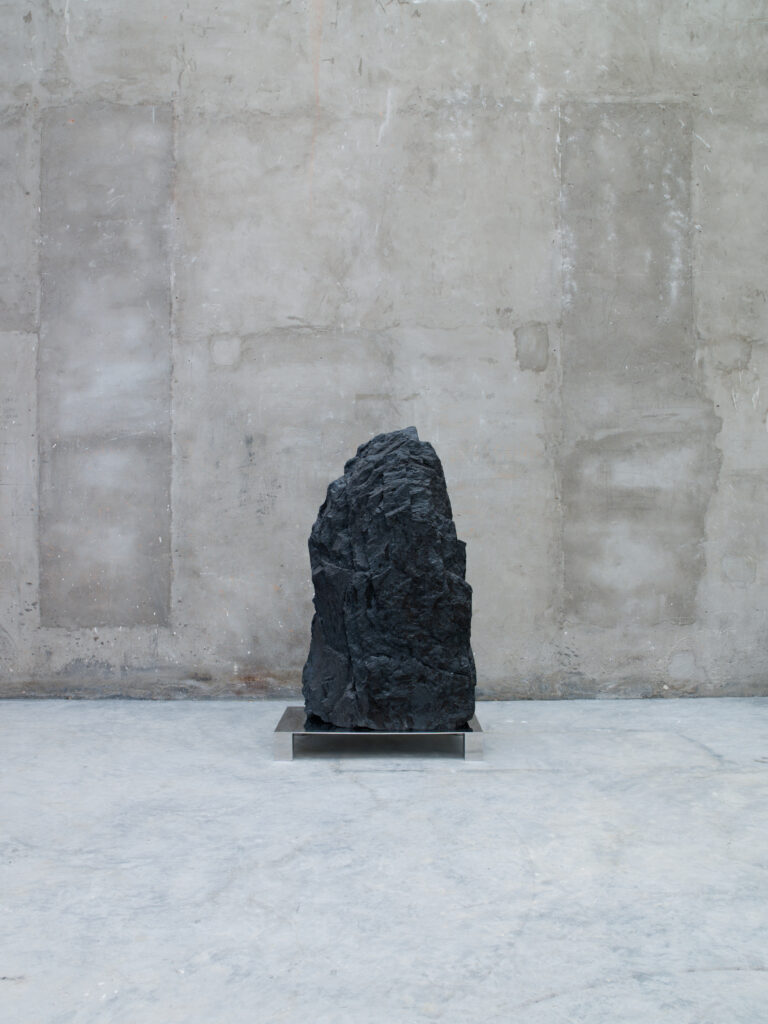
In certain works that meditate upon nature, Vital engages even more directly with Chinese art. An example in point is Piz Nair (2011), where he places, atop a pedestal, a block of polished, raw coal from the steppes of Mongolia. Named after one of the peaks of the Engadine, it shares the shape and monumentality of its namesake. This piece builds on the tradition of Gongshi or Chinese scholar’s stones, whereby Confucian literati would collect naturally-occurring rocks whose appearance is suggestive of a landscape or other natural features. Apart from their aesthetic quality, such rocks were seen to aid philosophical and spiritual contemplation. Vital, however, chooses a block of coal instead of a stone. In so doing, he connects the Engadine not just with Gongshi, but with the engine of China’s economic miracle and the cause of its environmental pollution. Though Chinese in inspiration, Piz Nair also belongs together with other natural objects – the tongue, the moustache, even cow dungs – that he has transformed into art. As such, the artist invites us to see new linkages and meanings within the syntax of an ancient tradition.
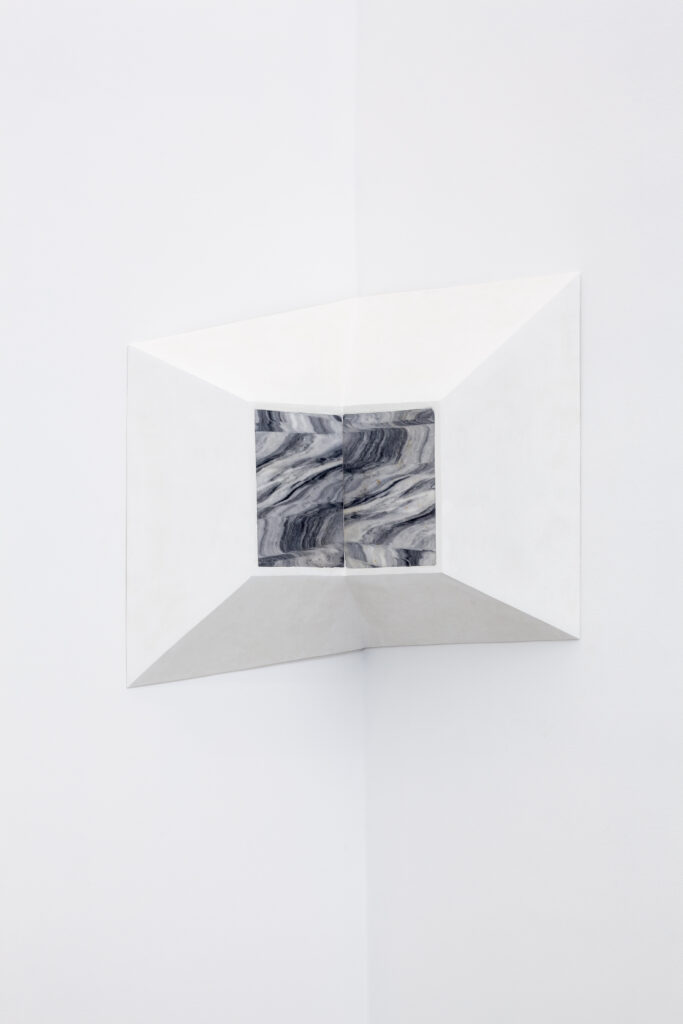
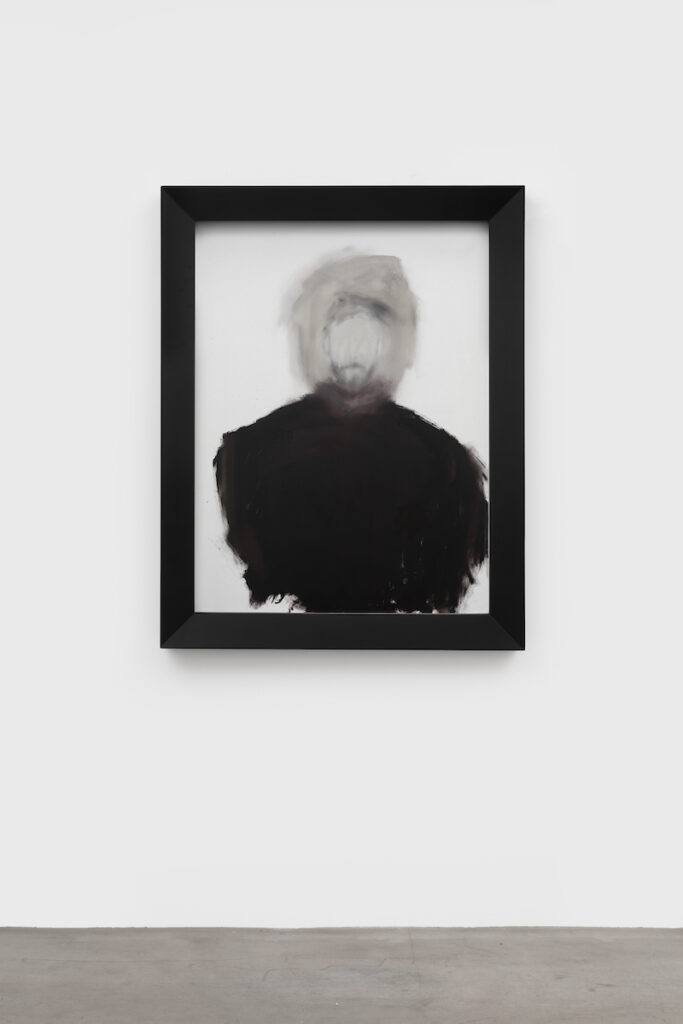
oil on canvas
120 × 90 cm (painting), 138 × 108 × 8 cm (image courtesy the artist and Galerie Urs Meile, Beijing-Lucerne)

oil on canvas
80 × 60 cm (painting), 94.5 × 74.5 × 8 cm (frame,)(image courtesy the artist and Galerie Urs Meile, Beijing-Lucerne)
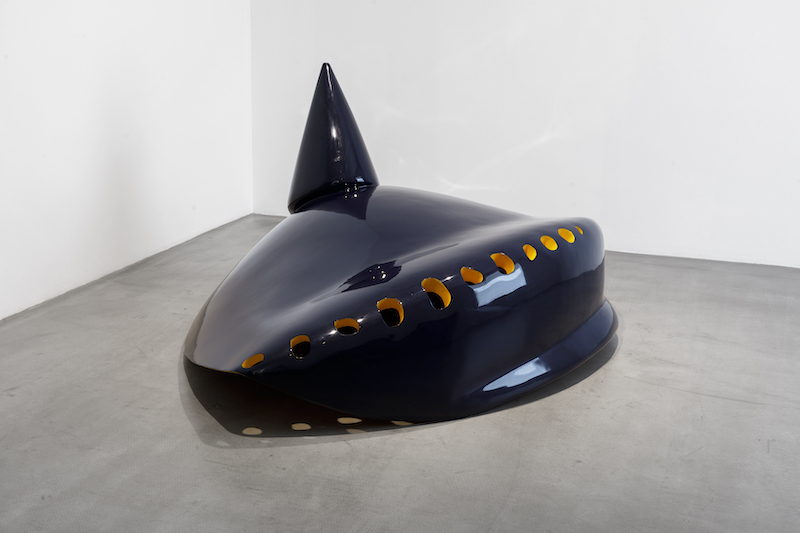
In like fashion, one finds nature mirroring nature in works such as Ice (2013) and Glacier (2013). These pieces are a contemporary take on Shihua or dream stones. In fact, they are delicate, thin slices of marble with hidden landscapes in their veins. ‘If you cut even a centimetre deeper,’ warns Vital, ‘you won’t get the same image.’ Having discovered Shihua in 2012, he incorporated them into his practice soon after. Here, the artist finds a convergence between, on one hand, his delight in transforming ordinary objects into art, and on the other, Chinese artistic tradition. In these stones, though, he envisions home with its snow-capped peaks instead of the immortal mountains of Chinese dreams. The Swiss allusion in each landscape is reinforced by an individualised plaster mount that, according to architect Norman Foster, evokes the window frames of the Engadine. These works speak of nature, but also of community and tradition. In them, the Alps seem separated from China’s dreamscapes of centuries only by a thin line of marble.


Nowhere is Vital’s awe of nature more in evidence than in SCARCH – sculptural structures that, by design, elude categorisation. This brings us back to the Sahara, where his ideas on the genre germinated. On a whim in 1999, he travelled to the desert city of Agadez, Niger. He had read about the Tuareg and the Peul nomads, whose peripatetic lifestyle speaks to him. Arriving late at night, by noon the following day the artist had drawn up plans for a house in the sand, identified a suitable plot of land and hired workers. The result, Mekafoni (‘House of Thorns’, 2001), was followed in quick succession by a school, Makaranta (2003), House to Watch the Sunset (2005), House to Watch the Night Skies (2005), House against Heat + Sandstorms (2006) and Mosque (2013). These buildings have varying degrees of practicality and stand on a moving spectrum between art and architecture. Vital’s SCARCH has been compared to ‘Follies’, erected as decorative amusement in 18th-century English and French landscaped gardens. To me, SCARCH has a lot in common with the meditation pavilions one finds in Japanese temple gardens or the retreats of the Chinese scholar-gentry. Far from frivolous, the artist’s structures have a contemplative quality to them. When we enter his spaces, we are invited to rethink art and architecture in relation to concepts of habitat, space and nature.



Vital’s House to Watch the Sunset, in particular, has become an important recurring form in his practice. He recalls that the house ‘was imagined in about 12 minutes. I knew the building would have to be taller than the palm trees. It had to be a tower.’ Built of sun-baked adobe bricks in a desert oasis, the artist’s creation has four storeys, each occupied by only one room of three-by-three metres. Every floor has one door, while the first floor has one window, the second two, and the third three. Each floor can only be accessed through one of three external staircases that also serves to stabilise the structure. In effect, asserts Vital, ‘nothing can be added’, for the building is a self-contained, sculptural totality unto itself. This minimalist formalism is a means to an end, that of contemplating the sunset. ‘Vital conceives his monumental sculptures,’ explains von Albertini, ‘as windows to the world. His houses yearn to see; for them having is nothing but seeing…And seeing is believing.’
Just as a house needs more than one window, so does the world as envisaged by the artist. ‘America builds a military base on every continent’, he reasons, ‘I decided to build a House to Watch the Sunset on every continent. Always the same form but using local materials.’ This mirrors his recreation of certain pieces, such as Tongue, in different materials and contexts to explore the full spectrum of possible meanings. Iterations of the house were constructed in 2016 in Paranádo Mamori in the Brazilian Amazon, and in 2018 on the grounds of Schloss Tarasp. Most recently, in 2021, one was fashioned out of prefabricated aluminium as a moving sculptural installation. Displayed initially at Venice’s Basilica di San Giorgio Maggiore, it is destined for the island of Fangasito in Tonga. This latest iteration re-conceives Vital’s original idea of using local materials since, with no human settlement, Fangasito is home to pure jungle wilderness. ‘There are only birds,’ recalls the artist, ‘and there should just be birds…the tower I’m going to put there is the tower of the birds.’
His pursuit of the sunset across the world sits in with the Little Prince’s story. The child-protagonist once sees the sunset on his minuscule planet 44 times in one day. ‘[O]n your tiny planet, my little prince’, remarks the Narrator, ‘all you need do is move your chair a few steps. You can see the day end and the twilight falling whenever you like…’ A chair is easier to move than a house of solid metal. But, the whole point of the exercise is that, round the world as the sun sets, one might just be tempted to imagine the impossible.
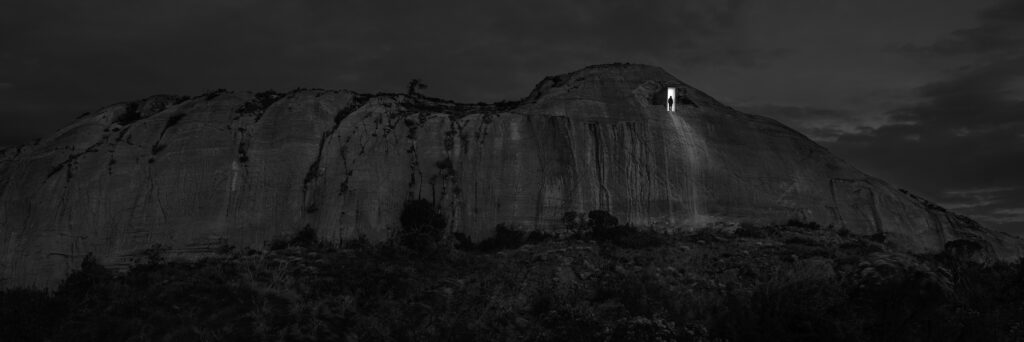
This sense of pushing the limits of our imagination is very much present in NotOna (2008–2014) in Patagonia, Chile. The project started as Vital’s search for a location for another House to Watch the Sunset. In the middle of Patagonia’s remote Lago General Carrera, one mountainous island of natural white marble seemed ideal. But upon arriving there in 2008, the artist was so struck by its crisp perfection that he decided not to build on the island. Reciting the artist Andy Warhol, his New York contemporary, Vital says: ‘I think having land and not ruining it is the most beautiful art that anybody could ever want.’ He admits, nonetheless, that since ‘the mountain is made of white marble…[it] gave me the impetus to sculpt.’
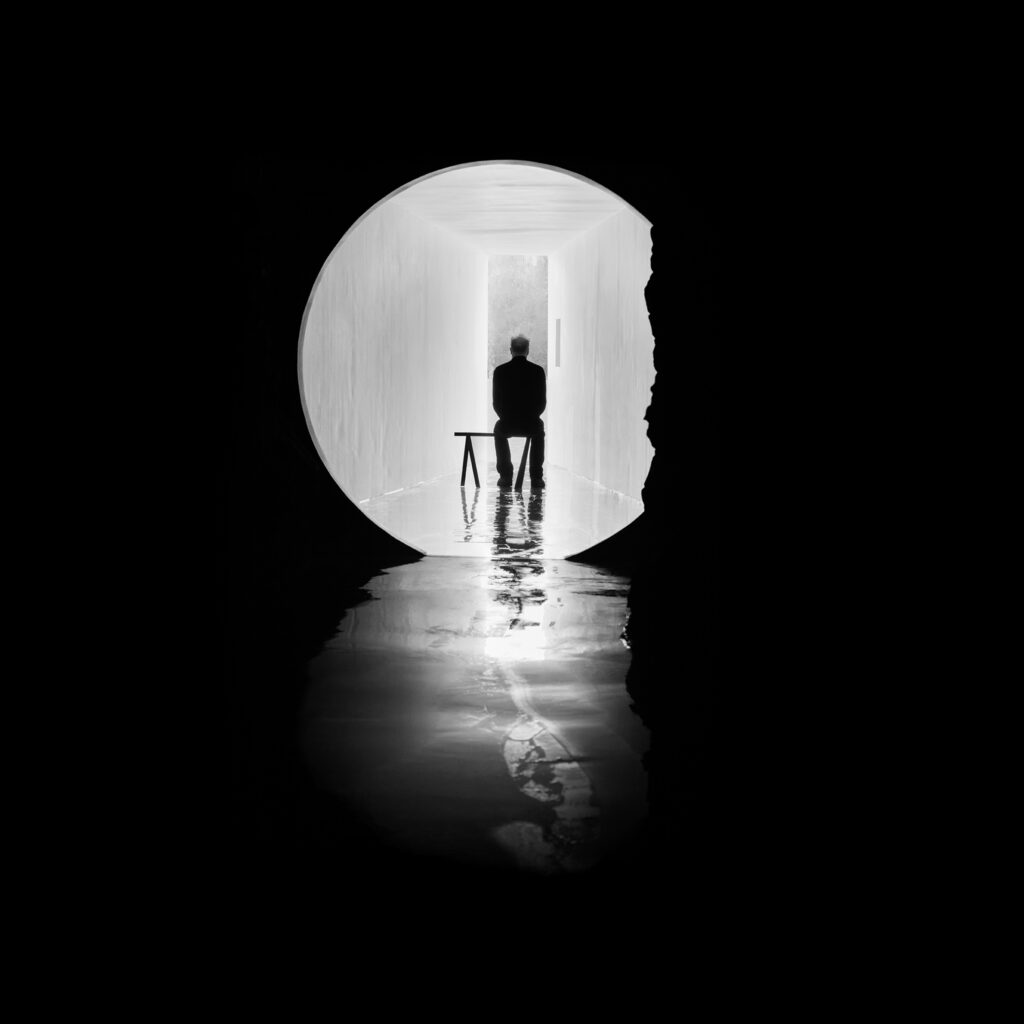


So, in a marvel of engineering, he sculpted a hidden habitat deep inside the island’s marble underbelly. It is in the form of a 50-metre-long tunnel that took his team years to excavate. In the middle is a domed, cave-like cupola, from where, through openings at both ends of the tunnel, you can look out and see the lake. Over glistening waters, reflected in white marble, they frame views of the sunset and the sunrise. Outside, as intended, almost nothing of the island is touched by the artist’s hand. The only discernable sign of his intervention is a cube of white marble on the shore, the residue and sum total of his excavation. We have here, writ large, the notion of hidden content, explored in earlier pieces like Camel. By being responsive to his immediate environment, Vital is able to present NotOna not only as a piece of unsullied nature, but also as a sculpture and a habitat for contemplation.
Such ideas are brought home to his sculpture park, the starting point of my sojourn in Vital’s wonderland. It was in this valley that the artist played in the woods as a child, building tree houses and creating tunnels in the snow. His teenage works with their sparse Romansch titles, Chanala da tet (‘Rainwater Gutter’, 1964) and Fatschada (‘Façade’, 1965), presage his adult interest in exploring the boundaries between art and architecture. Whether first drawn in the sand of the Sahara or wrought from Patagonia marble, the artist always recalibrates ideas from his travels back home on his annual return trips. The physical manifestations of this exercise populate his sculpture park. There is Tuor per ir pella bos-cha(‘Tower of Silence’, 2001), an edifice covered in hair that sways with the forest wind, like a sleeping fury giant from an Alpine fairy tale. There is also Chamonna da glatsch (‘House of Glass’, 2002), an igloo-like house of Murano glass that never melts. As ever in Vital’s oeuvre, appearances can be deceiving.

Amidst deliberate ambiguity, what strikes me the most in the artist’s practice is his ability to awaken in us a childlike capacity for curiosity and wonder. His invitation towards imagination asks us to open our minds to a universe of endless possibilities. With certain uncertainties, with thoughts of contrast and ambiguity, and with oscillating meanings all around us, is it possible to accept and embrace passionately this unknowable world? Vital admits, ‘it’s one thing telling a story, and quite another also living a story.’ Perhaps, then, it is appropriate that Nietzsche’s Übermensch forges meaning in life at the ‘stage of the child’, full of innocence and imagination. Standing with the artist on top of Palc, the physical stage where my visit began, I look out to the mountains before us. Here, shades of emerald, blue and white unfold across the valley. Their colours deepen as the fir forest closes in on our vision. Stand here, and you were gliding across the treetops like an eagle. Stand here, and you soared with the awe of a thousand innocents towards the mountain peaks. Stand here, and you were a child-hero once more: full of belief and undaunted by the impossible.
Ran Dian 燃点
About the writer: Adi Hong-Tan is an Indonesian historian, writer and social activist, working in art and heritage conservation. He read Law at Christ’s College, Cambridge University, and now sits on the Committee and Advisory Board of Yayasan Mitra Museum Jakarta [Friends of Jakarta Museums Foundation]. Adi Hong-Tan is a Contributing Editor to Ran Dian 燃点.